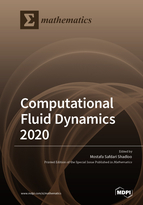Computational Fluid Dynamics 2020
A special issue of Mathematics (ISSN 2227-7390). This special issue belongs to the section "Dynamical Systems".
Deadline for manuscript submissions: closed (31 January 2021) | Viewed by 60770
Special Issue Editor
Interests: turbulence; computational fluid dynamics (CFD); multiphase flows; meshless methods; high performance computing (HPC)
Special Issues, Collections and Topics in MDPI journals
Special Issue Information
Dear Colleagues,
Hitherto, experimental approaches have been widely considered as the main source of information for predicting the physical behavior of fluid flow problems. However, in many applications, due to the complexities in fluid behavior regarding to its nonlinearity, multiscale status, multiphase, etc., experimental means have become either extremely expensive, subjected to scaling issues or, in some cases, impossible. Under these constraints, the only alternative method of scrutinizing this physical phenomenon seems to be through numerical tools.
This Special Issue focuses on computational fluid dynamics (CFD) research, with an emphasis on its recent advancements and its use in many industrial/academic applications. Papers ranging from new physical modeling and discoveries to the correct treatment of difficulties inherent in numerical modeling of fluid flow systems are invited for submission. These include but are not limited to: (i) Correct and effective models of the physical boundary conditions; (ii) mass and energy conservations; (iii) realistically treating the complicated physical phenomena; (iv) extendibility to dealing with more multiphysics phenomena, such as those in magnetohydrodynamics (MHD), electrohydrodynamics (EHD), non-Newtonian flows, phase change, nanofluidic, etc. problems; and finally, (v) the extension of aforementioned methodologies to three-dimensional modeling and massively parallel computing in order to handle the real-life problems.
We concisely invite manuscripts that focus on the use of conventional numerical methods, such as finite difference (FDM), finite volume (FVM), and finite element (FEM), to elaborate on their differences, similarities, advantages, and drawbacks. As such, the development and validation of less established and newly attracting numerical methodologies, such as smoothed particle hydrodynamics (SPH), moving particle semi-implicit (MPS), Lattice Boltzmann (LBM) methods, etc. are also in the core scope of this research topic. Manuscripts dealing with the benchmarking of new test cases, optimizing flow, fluid, geometrical parameters, as well as using data-driven approaches, such as reduced order methods and machine learning (ML), are of great interest. This Special Issue also welcomes related novel inter-/multidisciplinary works in the emerging area of mechanical, chemical, process, and energy engineering.
Prof. Mostafa Safdari Shadloo
Guest Editor
Manuscript Submission Information
Manuscripts should be submitted online at www.mdpi.com by registering and logging in to this website. Once you are registered, click here to go to the submission form. Manuscripts can be submitted until the deadline. All submissions that pass pre-check are peer-reviewed. Accepted papers will be published continuously in the journal (as soon as accepted) and will be listed together on the special issue website. Research articles, review articles as well as short communications are invited. For planned papers, a title and short abstract (about 100 words) can be sent to the Editorial Office for announcement on this website.
Submitted manuscripts should not have been published previously, nor be under consideration for publication elsewhere (except conference proceedings papers). All manuscripts are thoroughly refereed through a single-blind peer-review process. A guide for authors and other relevant information for submission of manuscripts is available on the Instructions for Authors page. Mathematics is an international peer-reviewed open access semimonthly journal published by MDPI.
Please visit the Instructions for Authors page before submitting a manuscript. The Article Processing Charge (APC) for publication in this open access journal is 2600 CHF (Swiss Francs). Submitted papers should be well formatted and use good English. Authors may use MDPI's English editing service prior to publication or during author revisions.
Keywords
Dear Colleagues,
This Special Issue focuses on computational fluid dynamics (CFD) research, with an emphasis on its recent advancements and its use in many industrial/academic applications. Papers ranging from new physical modeling and discoveries to the correct treatment of difficulties inherent in numerical modeling of fluid flow systems are invited for submission. These include but are not limited to: (i) Correct and effective models of the physical boundary conditions; (ii) mass and energy conservations; (iii) realistically treating the complicated physical phenomena; (iv) extendibility to dealing with more multiphysics phenomena, such as those in magnetohydrodynamics (MHD), electrohydrodynamics (EHD), non-Newtonian flows, phase change, nanofluidic, etc. problems; and finally, (v) the extension of aforementioned methodologies to three-dimensional modeling and massively parallel computing in order to handle the real-life problems.






